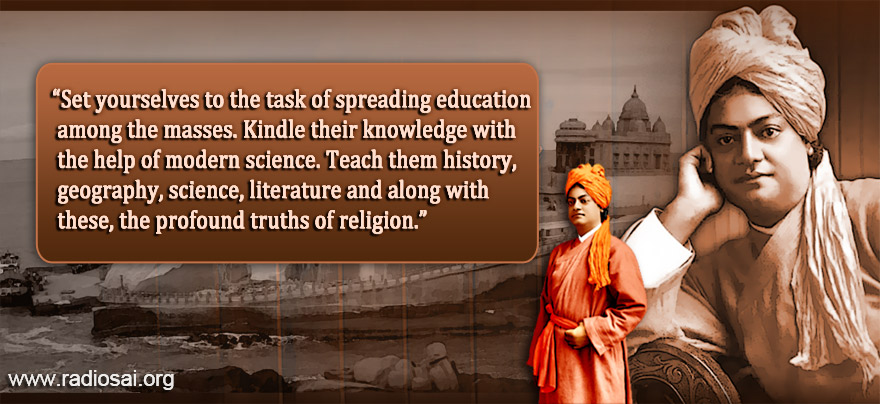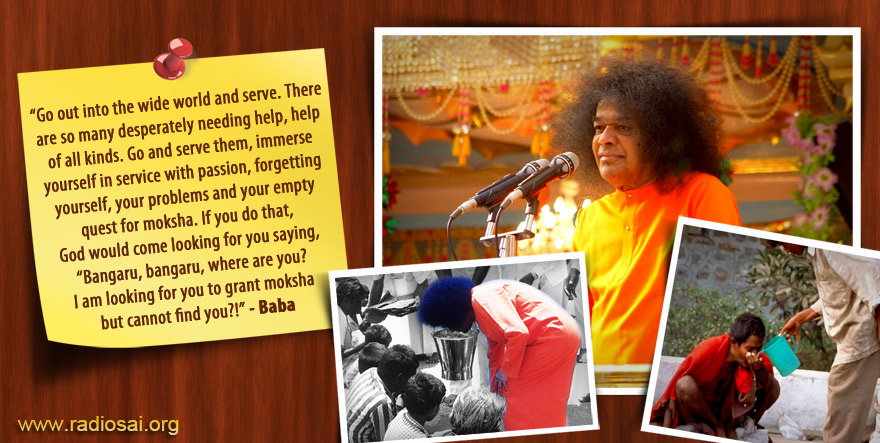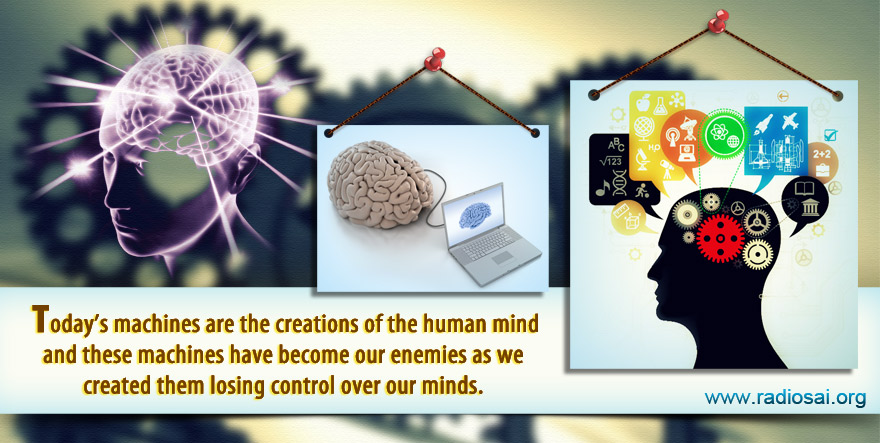|
|
| 'Like' us on Facebook | Follow us: |
Posted on: Mar 09, 2014
 |
In the campuses of Sri Sathya Sai Institute of Higher Learning the first hour every Thursday is a 'Moral Class'. Bhagawan Himself used to address the students on many of these occasions especially in the initial years of the university, and at times even during the nineties. Since the beginning, this hour has been reserved to seriously reflect on Swami's teachings and this is done through variety of programmes which includes talks by eminent personalities, panel discussions, quiz competitions, cultural presentations and so on.
On the last Thursday of January 2014 Prof. Venkataraman, who has served earlier as a Vice Chancellor of this University, was invited to speak to the students. That day also happened to be Martyrs' Day (January 30), dedicated to the memory of Mahatma Gandhi. The learned professor did make a reference to Gandhiji in his speech even as He deliberated on the immense importance and relevance of Swami's message in the present times if mankind has to progress in the right direction towards creating a society where harmony and order are not exceptions but the natural state of being. Presented below is the transcript of this talk.
Part 01
At the outset, I would like to offer my humble pranams at the Lotus Feet of our Most Beloved Bhagawan.
Dear students and members of the faculty, thank you all for giving me the opportunity to be with you again.
And my very special greetings to Mr. Chakravarthi whose association with the Institute goes far beyond all the rest of us here, and to Prof. Viswanath Pandit who too has served the Institute in multiple capacities. I feel deeply honoured by your presence here this morning.
It is a very humbling experience to be back on this hallowed stage here. Many, many memories come rushing back, but dominating them all is the vision of Swami in His infinite compassion, exerting Himself so much to give us His teachings. Few of us appreciate that what He did just once when He came as Sri Krishna, He repeated over a thousand times, when He came back in this Kali Age. How many times has He spoken from this very stage! Sadly, few truly understand how critically important and powerful is the message Bhagawan gave us, especially for solving so many of the problems afflicting humanity at the present time. By way of highlighting this point, I wish to speak today about GROWTH, STABILITY AND ORDER.
The Modern Myth About Consumption and Growth
There is a widespread belief that ceaseless growth of GDP is the only option available for achieving so-called progress. Closely linked to this is another false dogma which is that such growth comes only through endless consumption. This is the great mantra of the free market that most people readily buy into, including devotees. Presently, a large fraction of humanity is immersed in a massive consumption mela. This amazes as well as frightens me, particularly because the idea of having unnecessary wants goes against the very basic teaching of Swami, namely, placing a ceiling on desires.
Before I start talking about all this, we have to remember that today is January 30, the death anniversary of one who is hailed as the Father of our Nation. Personally, I would like to remember Mahatma Gandhi for more than the usual reasons. And that has much to do with a book I happened to read way back in 1944. It was a Tamil book I had borrowed from the small library attached to the South Indian Association in Karachi. I happened to be in that city because my father was serving there as an officer of the India Meteorological Department.
The Tamil book began with below words:
.jpg) |
Both went overseas in 1893. Vivekananda came back early and spent the remaining years of his life working passionately for the poor. He died in 1902. Gandhi, on other hand, came back only in 1921, and he too, in his own way, served the poor and the downtrodden of India, till he was cruelly removed from our midst in 1948. I mention these two great sons of India because in the context of today, both said something very different. Yet, both of them were right! How could that be? There lies the mystery and also the substance of my talk.
The Essence of Swami's Vivekananda's Teachings
Let me begin with Vivekananda whom Nehru referred to as the cyclonic Hindu. He was born on January 12, 1863 and given the name Narendranath Dutta. In 1881, Vivekananda saw Ramakrishna Paramahamsa for the first time, and quickly become his favoured disciple. Shortly before Ramakrishna gave up his body in 1886, he ordained Vivekananda as a monk.
In 1887, after giving formal shape to the monastery, Vivekananda began to roam the country as a wandering monk. In 1892, Vivekananda visited Kanyakumari, swam the ocean to reach a solitary rock there, sat on it and meditated. Later he wrote:
At Cape Comorin sitting in Mother Kumari's temple, sitting on the last bit of Indian rock—I hit upon a plan: We are so many sanyasis wandering about, and teaching the people metaphysics—it is all madness. Did not our Gurudeva used to say, 'An empty stomach is no good for religion?'
We as a nation have lost our individuality and that is the cause of all mischief in India. We have to raise the masses.
Please keep this in mind, especially because our Beloved Swami reminded us ever so many times about our obligations to serve society.
In 1893 Vivakananda, though penniless, somehow managed to go to Chicago to attend the World Parliament of Religions. He made such an electrifying impact there that he spent many years overseas, and came back only in 1897. After a stay of two years in India, Vivekananda went overseas again and came back in 1900. His foreign tours were now over and Vivekananda dedicated himself to the task he had sworn to, way back in Kanyakumari in 1892. And he did so tirelessly till he himself gave up his body in 1902.
Recently, I picked up a volume from the collected works of Vivekananda which I had purchased way back, and began reading it. In it was reported a conversation between Vivekananda and one of his disciples who was a monk himself. The disciple is asking questions about seeking Brahman and wonders why he should be bothered about the world and its problems, especially when it was all illusory anyway.
I now wish to quote some excerpts from Vivekananda’s reply but before I do that I should mention that America made a deep impression on Swamiji. He detested its materialism and forecast that one day America would drown in it. So far, that has not happened but excessive materialism has sure brought its quota of problems. On the other hand, Vivekananda was also deeply impressed by the dynamism of the American people, their spirit of enterprise, willingness to work with their hands and get things done. In short, Vivekananda admired the famous can-do spirit of Americans. He was dismayed that learned people in India hardly bothered about such matters and when his disciple asked a question about seeking Brahman, he replied sharply:
Going around the whole world, I find that the people of this country are immersed in great Tamas or inactivity, compared with people of other countries… It is as if the blood has become congealed in the heart, so that it cannot circulate in the veins – as if paralysis has overtaken the body and it has become languid. So my idea is:
First make the people active by developing their Rajas, and then make them fit for the struggle of existence.
Laziness, meanness and hypocrisy have covered the whole length and breadth of this country. Can an intelligent man look on all this and remain quiet? … You consider yourself educated. Fie upon you. Is this education? What is the goal of your education? Either a clerkship, or being a roguish lawyer, or at the most a Deputy Magistracy, which is another form of clerkship.… Open your eyes and see what a piteous cry for food is rising from the land of Bharatha, proverbial for its wealth! Will your education fulfil this want? Never!
I say, set yourselves to the task of spreading education among the masses. Kindle their knowledge with the help of modern science. Teach them history, geography, science, literature and, along with these, the profound truths of religion. Arouse the Rajas within them – make them fit for the struggle for existence, and then speak to them about salvation. First make the people of this country stand on their legs by rousing their inner power for activity; first let them have good food and clothes and plenty of enjoyment; then tell them how to be free from bondage.
 |
Frankly, when I first read this passage, I was totally unprepared for it. It was only later that I could connect it with what Vivekananda had recorded after his meditation in Kanyakumari. Just to recall, he had said:
Did not our Gurudeva used to say, 'An empty stomach is no good for religion?' We as a nation have lost our individuality and that is the cause of all mischief in India. We have to raise the masses.
Which brings to my mind a Discourse Swami gave many years ago in Sai Kulwant Hall. I do not recall the year or the occasion. All I can remember was that it was a hot afternoon and the time was around 3:30 or so. The audience was in a drowsy mood when Swami suddenly burst out and said angrily:
You all want moksha! What is this obsession about moksha?
And then in a mocking tone, He added:
Moksha, moksha, moksha! How selfish! You want moksha while people around you are suffering? Do you think God grants moksha to selfish people?
Go out into the wide world and serve. There are so many desperately needing help, help of all kinds. Go and serve them, immerse yourself in service with passion, forgetting yourself, your problems and your empty quest for moksha. If you do that, God would come looking for you saying, “Bangaru, bangaru, where are you? I am looking for you to grant moksha but cannot find you?!”
 |
Suddenly every one sat up feeling electrified and Sai Kulwant Hall echoed to a thunderous applause.
Gandhiji and His Pillar of Strength
Let me now turn to Gandhiji. He too left the shores of India in 1893, but he came back much later, i.e., only in 1921. Unlike Vivekananda who went overseas with a purely spiritual objective, Gandhi went to South Africa to offer legal help to a party there. He then settled down to practice law and live like a normal householder.
That said, there was a strong spiritual streak in Gandhi, and being an avid reader, he not only read all he could but also tried hard to put into practice what he had read and absorbed. One thing led to another, he ended up, shall I say, inventing Satyagraha, and making it his life’s creed. To my mind, Gandhi was the only politician who dared to practice the Gita, even while engaged in politics. That is why he never compromised on moral principles and emphatically declared that even if the whole world was against him he would do only what his Conscience dictated.
The Man-Machine Interaction in the Modern Times
With that preamble, let me move on to something that is most relevant to what is happening today, which is the extra-ordinary takeover of our lives by technology. According to studies in anthropology, humans crept out of caveman like existence barely 10,000 years ago. Till the 19th century progress was slow and steady, but after the advent of the industrial revolution the change not only became faster but actually began to accelerate.
Scholars identify three phases in the (ongoing) industrial revolution. The first phase which started in the 19th century lasted till the beginning of Second World War. During this period, machines basically removed a lot of drudgery. To put it differently, it was machines versus muscles, and humans were willing to let machines have their say. I mean, no one would argue that it is far better to go by train to the holy city of Kasi, rather than walk all the way.
The second phase of the industrial revolution extended from 1945 to about 1975 or so. This was the period when life was made easy and comfortable by gadgets like the refrigerator, washing machines, colour TV, and so on. Once again, humans considered machines to be useful and did not feel threatened.
The third phase of the Industrial Revolution which started around 1975 and continues to this day has proved to be qualitatively different and even disastrous in many respects. This is because factory machines have begun to become increasingly computerised, which has led to many people with relatively low-level skills losing their jobs in the manufacturing sector.
 |
Presently, machines are morphing into advanced computers with sophisticated Artificial Intelligence embedded into them, and this is a real threat to even educated humans.
Maybe, I should add a few amplifying remarks here. In the eighties or thereabouts, IBM used to make super computers that played chess and asked grandmasters to play against their computer. In the beginning, the masters were able to easily outplay the computers but soon there came a time, when computers were so powerful that grandmasters found it difficult to beat the machine.
At that time it all seemed like IBM was spending a lot of money producing fancy machines that served no real purpose. That was what most people outside the industry thought.
For IBM, however, designing and building chess-playing computers was just the beginning. A few years ago, it embedded artificial intelligence or AI into its machines converting them from mere number crunchers into systems with “intelligence.” And one fine day this new computer named Watson (after the founder of IBM) was able to beat the national champion of America in TV game show called Jeopardy. Now IBM is flexing its muscles and is on the verge of marketing a computer that would do the job of chief accountants of commercial firms. Imagine what that means – when it hits the market, this machine is going to make thousands of accountants lose their jobs. Likewise, driverless cars and trucks too are soon expected to be sold in large numbers, which would result in large numbers of truck and taxi drivers losing their jobs. Whether we like it or not, machines are increasingly making humans subservient to them, and in many cases totally dispensing with the latter. In passing we may note that machines which have now become the foe of humans are actually the creation of the human mind – in other words, this enemy has not come from somewhere outside but created by humans, losing control over their minds.
Impact of Machines on Human Society
Let me now discuss in some detail how machines have impacted human society. Since America has been at the forefront of both Science and Technology, especially after the Second World War, I shall, for the moment, focus on that country. Right from the beginning, America has been the citadel of private enterprise and capitalism. Almost everyone there believed (and a good many still do) that it was best for society to allow talented entrepreneurs to become wealthy, because a part of the money earned by them would flow into society via expenditure by the rich. As President Kennedy put it, the rising tide lifts all boats. In a manner of speaking, this philosophy did work till around 1975, i.e., end of what I called phase II of the industrial revolution. There were many important reasons for this, some of which are the following:
-
Due to government regulations, labour got a fair deal.
-
Manufacture dominated the economy and provided jobs to tens of millions. This in turn supported other subsidiary sectors.
-
The wealth gap at that time was small since the rich were taxed substantially.
-
Most important of all, there was a ladder of opportunity that allowed even the ordinary factory worker the chance to go up by working hard, at least to a reasonable extent and retire comfortably.
The bottom line was: Every new generation had a better life than the previous one.
The advent of phase III of the Industrial Revolution changed the entire situation on its head, and reasons for this include the following:
-
The old model of regulated capitalism was replaced by totally deregulated free-market capitalism. Essentially, life was reduced to a zero-sum game with winners and losers. Worst of all, the winner took everything leaving barely crumbs for the loser; yet, this was considered fair.
-
Technology played a key role in facilitating this. Thanks to it, money and jobs could be moved at the speed of light and products mass produced cheaply in low-income countries could be moved across the globe in huge container ships and massive cargo planes.
-
As a part of these so-called economic reforms, the rich were taxed lightly while the working class lost not only many basic labour rights but also a wide range of social benefits.
The net result of it all was that a large fraction of the national wealth was created not by the sweat of people’s labour but by what was called the financial industry. At its best it meant wealth creation by taking huge risks, i.e., essentially by betting. At its worst, it meant making money by cheating on a large scale.
 |
For a while this laissez-faire model of economy seemed to work well. But once the gloss wore off, it became clear that while the rich became richer, the middle class slipped behind. Not only did their wages remain stagnant, but in real terms they actually went down due to inflation. As for the poor, few bothered about them.
Meanwhile, the ladder of opportunity lost many intermediate steps. As a result upward mobility, which once was taken for granted, now became very hard. Finally, thanks to excessive risk taking, there were many economic bubbles, the two most disastrous ones being the housing bubble in 2007 and Wall Street collapse in 2008. The latter of course sent shock waves across all countries which had enthusiastically embraced the free-market philosophy.
What do you think about this article? Please let us know by writing in to h2h@radiosai.org. Do not forget to mention your name and country.








